INAUGURAL–DISSERTATION zur Erlangung der Doktorwürde der ...
INAUGURAL–DISSERTATION zur Erlangung der Doktorwürde der ...
INAUGURAL–DISSERTATION zur Erlangung der Doktorwürde der ...
You also want an ePaper? Increase the reach of your titles
YUMPU automatically turns print PDFs into web optimized ePapers that Google loves.
12 2. Mathematical Modeling<br />
ods. In the Lagrangian particle tracking method, the gas phase behavior is typically<br />
predicted by solving the unsteady Reynolds-averaged Navier – Stokes equations with<br />
an appropriate turbulence model and sub-models for various source terms [35, 37, 72].<br />
In this method, droplets are injected into the gas and their trajectories are tracked by<br />
numerically evaluating the Lagrangian equations of motion.<br />
A typical spray consists of a large number of droplets and with limited computational<br />
resources, numerical parcels are implemented instead of droplets where each<br />
parcel contains several number of droplets. The Euler–Lagrangian models are classified<br />
as locally homogeneous flow (LHF) method [73–75] and separated flow (SF)<br />
method [76–78].<br />
The locally homogenous flow approximation of the LHF model for two-phase flow<br />
problems implies that the interphase transport rates are infinitely fast, so that both<br />
phases have same velocity and are in thermal equilibrium at each point of the flow [75].<br />
This model neglects the slip effect between the liquid phase and gas phase. LHF<br />
approximation is the limiting case, which accurately represents spray with very small<br />
droplets [72].<br />
Compared with the LHF model, the SF model has been used more widely in multiphase<br />
flow problems, because it provides the finite rate exchange of mass, momentum<br />
and energy between the phases [72]. The SF model assumes that each phase<br />
displays different properties and flows with different velocities, but the conservation<br />
equations are written only for the combined flow. In addition, the pressure across<br />
any given cross-section of a channel carrying a multiphase flow is assumed to be the<br />
same for both phases [72]. The SF models are further subdivided into discrete droplet<br />
model (DDM) [76–78], continuous droplet model (CDM) and continuous formulation<br />
model (CFM). The differences in these methods are explained by Faeth [72].<br />
In DDM, the spray is divided into representative samples of discrete droplets whose<br />
motion and transport are tracked through the flow field, using a Lagrangian formulation.<br />
This procedure computes the liquid properties based on finite number of particles,<br />
called as parcels which are used to represent the entire spray [72, 76]. The gas phase is<br />
solved using Eulerian formulation, similar to the LHF method. The effect of droplets<br />
on the gas phase is consi<strong>der</strong>ed by introducing appropriate source terms in the gas<br />
phase equations of motion. This type of formulation is is found to be convenient for<br />
consi<strong>der</strong>ing a relatively complete representation of droplet transport processes [72].<br />
The CDM was first introduced by Williams [79]. In this method, droplet properties<br />
are represented by a statistical distribution function defined in terms of droplet<br />
diameter, position, time, velocity, temperature, etc. [80]. Conservation principles yield<br />
a transport equation for the distribution function, which is solved along with the gas<br />
phase equations to deduce the properties of the spray [72, 79, 80]. Similar to DDM,













